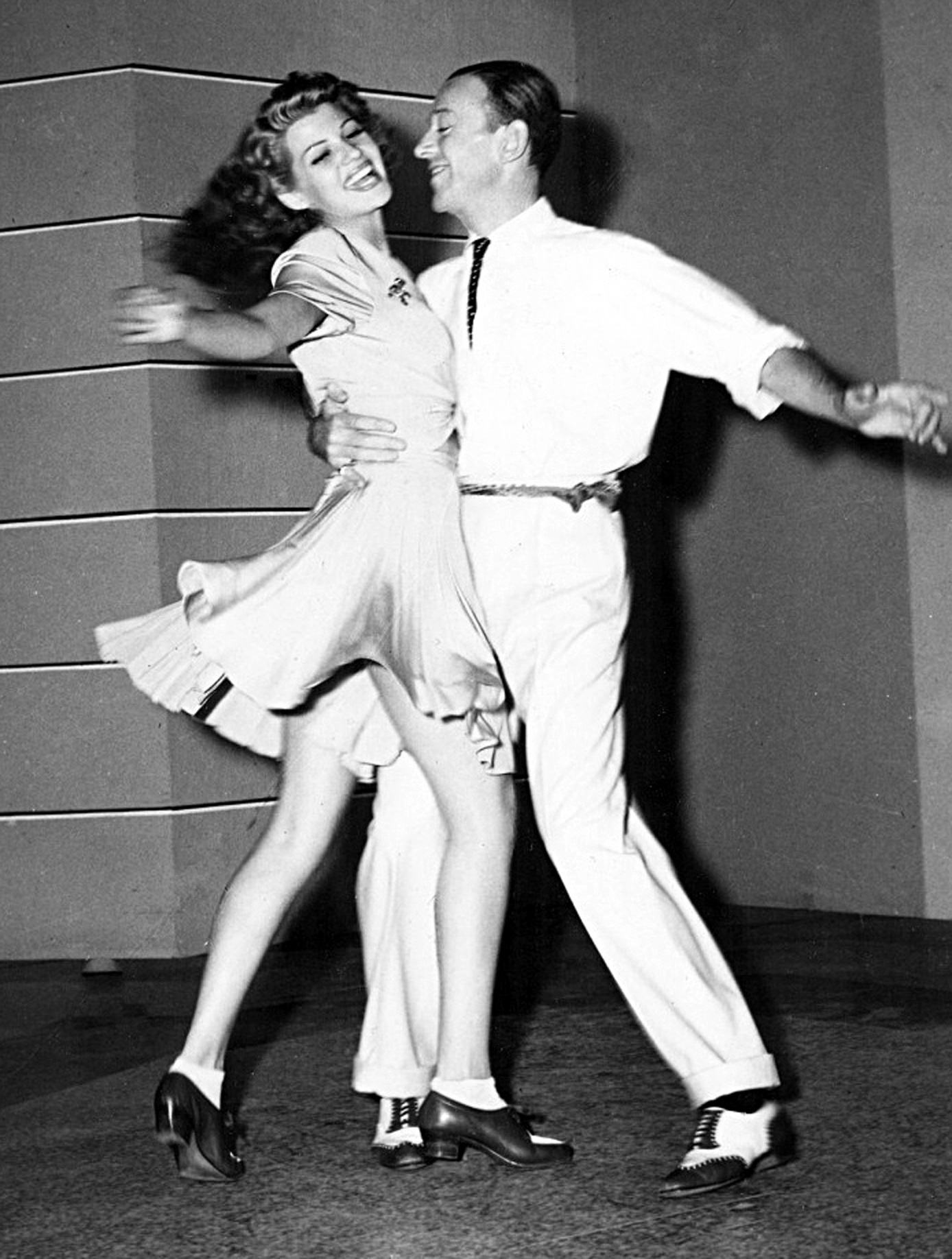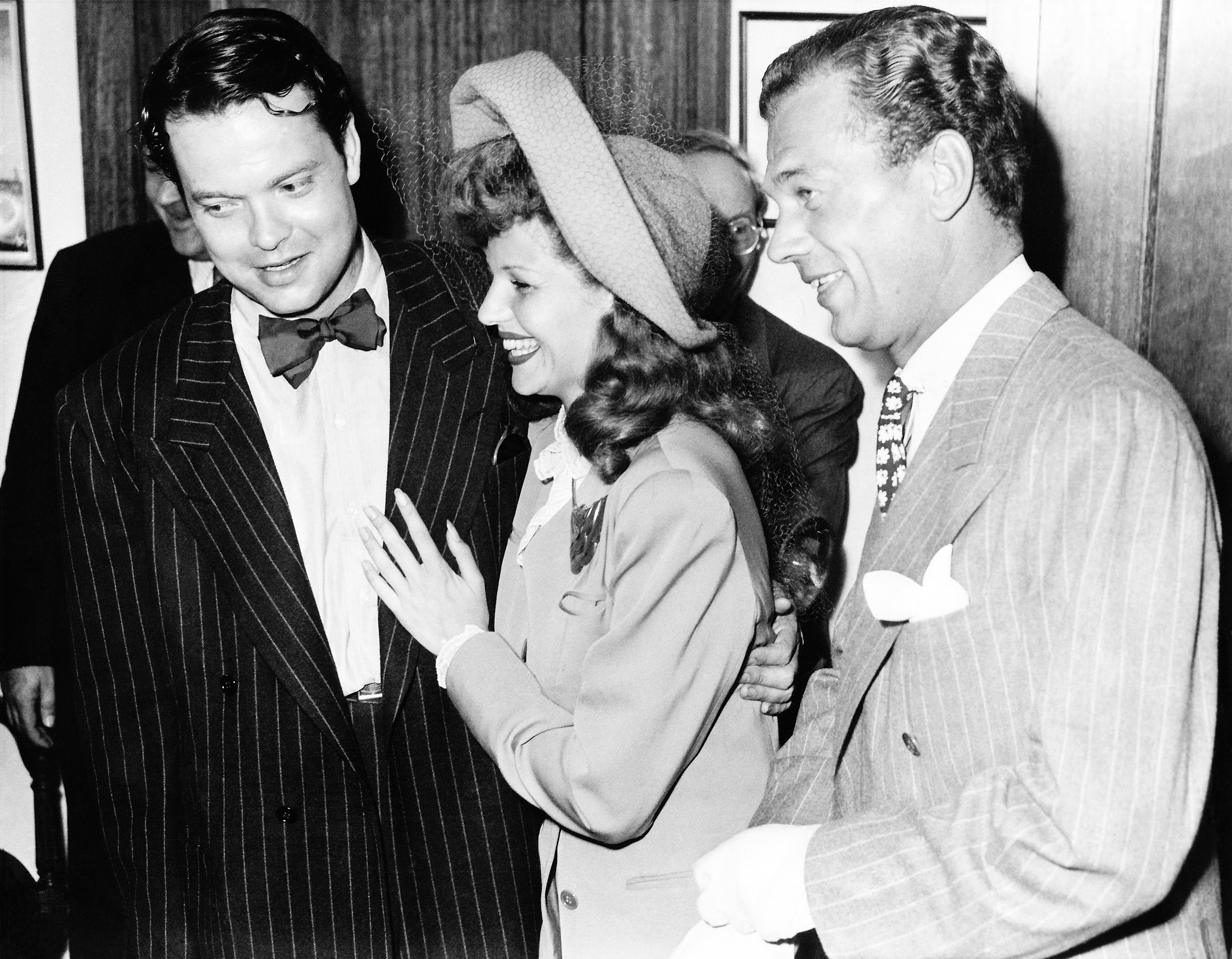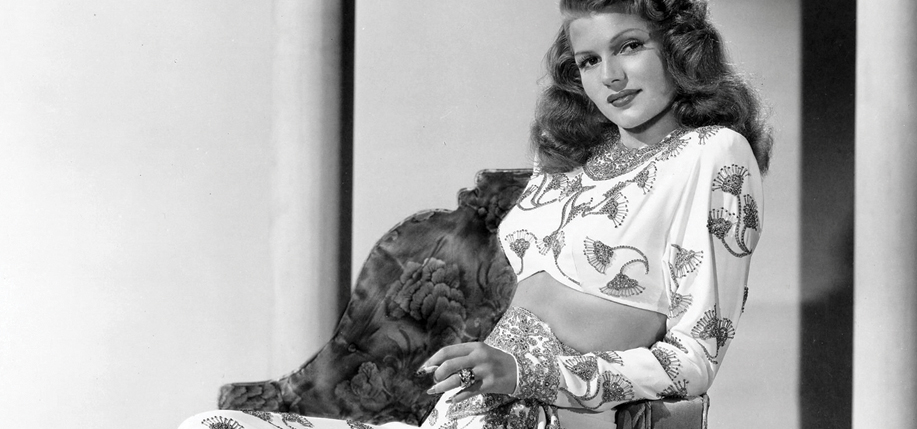The tragic star who burned too bright but always gave the loveliest light.
Her mother, the improbably named Volga, was an ex-Ziegfeld Girl, born to a printer, Allynn Hayworth, and his wife, Maggie O’Hare, the daughter of Patrick and Bridget O’Hare, immigrants from Ireland. Her father, Eduardo Cansino, as black-hearted a villain as ever lived (saving a few of her husbands), was an exotic Spanish dancer and son of the man who introduced a sensuous dance, the Bolero, to Americans. Her parents settled into a humble Brooklyn apartment where she was born in 1918. Volga wanted to name her daughter Margaret after her mother, but Eduardo insisted on Carmen. They compromised, probably for the only time, and named the baby Margarita Carmen. Years later, Margarita shortened her first name, took her mother’s maiden name and became, arguably, the most glamorous woman who ever lived, Rita Hayworth.
The Cansino family increased by two sons and, in the interest of his career, Eduardo moved his family to Southern California, where he gave dancing lessons to studio players. In 1930, the Depression forced Eduardo to close his studio and go on the road. He was looking around for a new dancing partner when his leer landed close to home on his 12-year-old daughter. He pulled Margarita out of school, made her up to look older, taught her his dance routines, and began his ritual sexual abuse. The Dancing Cansinos, posing as husband and wife, art imitating sordid life, took their act to the underbelly of show business, Mexican border towns, gin mills, and casinos. Margarita followed her father’s rules by dancing seductively, flashing her eyes, and submitting, nightly, to rape.
Every time Margarita returned home, her mother tried to protect her, bringing her into her bed, but Volga was penniless, powerless and slipping into chronic alcoholism. A picture of young Margarita at this time shows a “roly-poly” girl staring into space, too shy to join with other children, even her younger brothers. Like most victims of incest, she had learned to disassociate, distance herself psychologically and go to another world. Many years later she explained that she would retreat into an imaginary carousel ride, “If I don’t like where I am, if I don’t like me… I hear the music, I’m on a horse, I’m on the carousel.”

Their dancing tours weren’t proving too profitable, so Eduardo looked for other ways to monetize his child. Margarita worked as an extra in Mexican films and was finally cast in a 1935 Fox film, Dante’s Inferno, starring Spencer Tracy. The acutely withdrawn girl stepped outside her shy self, danced a sensuous dance and inspired a press release describing her as a, “beautiful sixteen-year-old Spanish-Irish dancer who has circled the globe a dozen times.’’ Still, she was dropped. Eduardo Cansino needed help and he turned to Edward Judson, a character as loathsome as himself, a much older, thrice-married grifter and snappy dresser who claimed to be an oilman, though the oil he proffered was pure snake.
Judson saw Rita as an “investment,” and married her to control her money. He pushed Eduardo out of the picture along with any traces of her ethnicity – electrolysis removed her widow’s peak and her black hair was dyed red. He put her on a diet, the better to squeeze into tight (rented) gowns for publicity shots at the Trocadero. In addition to playing Pygmalion to his wife, Judson played pimp, offering her up to various producers. In the end, he was successful. Rita got a seven-year contract with Columbia.
The head of Columbia Pictures, Harry Cohn, the Harvey Weinstein of his day, gorged on his starlets, viewing them as commodities to satisfy his outsized libido. Judson assured him that Rita soon would be his. Cohn, obsessed with Rita, attempted to control her by bugging her dressing room, issuing fines, and forcing her to punch a time clock even when she was his biggest star. In a rare show of empowerment, Rita refused her husband and refused to bed Harry Cohn. Judson, feeling his grip slipping, threatened her with, among other imaginative forms of disfigurement, throwing lye in her face.
By 1941 Rita’s life was a nightmare, menaced by her husband at home and stalked by her boss at work but, using the technique developed as a child, she detached. She was able to check out of the misery of her life, light up the screen and make an entire country fall in love with her. In 1941, she stole the show from bigger names in The Strawberry Blond, and danced with Fred Astaire in You’ll Never Get Rich. Astaire later claimed she was his favorite dancing partner, saying, “Nothing is too difficult for her. She watches, goes home, practices up, and the next day she’s got it perfect.” After turning over all her assets to Judson, she was able to divorce him in 1942, but was left so broke she asked her friend Hermes Pan if she could eat at his home.
Just as her dark hair turned red, her ethnicity disappeared and a new persona emerged, the Love Goddess. No longer Hispanic or Irish, she was now an all-American girl and, after starring with Gene Kelly in Cover Girl, it seemed technicolor was invented just for her. The iconic 1941 Life magazine photograph of Rita kneeling on a rumpled bed wearing a satin nightgown and welcoming smile was a favorite pin-up of GIs during World War II.
In the film noir, 1946’s Gilda, she begins a sultry striptease to “Put the Blame on Mame,” a cinematic milestone that landed her on the nose of an atomic bomb. It also gave rise to her ubiquitous quote, “Men fall in love with ‘Gilda,’ but they wake up with me.” It was a poignant statement that reflected on how trapped she was in her image. The public fetishized her as goddess or raging siren, but it was a manufactured, one-dimensional image – in reality, she was pathologically shy, passive, and needy and would always remain that way.
Upon seeing Rita’s 1941 Life photo, “boy genius” Orson Welles announced, before even meeting her, that he would marry her, which he did in 1943, becoming, as she always claimed, “the love of my life.” She read all the high-brow books he assigned her, though it’s doubtful she ever reached his conversational level. “The Beauty and the Brain” became the most prominent leftist Democrats in Hollywood, even sending out Christmas cards soliciting funds for the anti-fascists in Spain. But by the time their daughter Rebecca was born, Orson, overwhelmed by Rita’s insecurity and jealousy, submerged himself in his work. For some perverse reason, men married to desirable women often have affairs with undesirable women, and Orson Welles did just that. Hollywood wags reported his infidelities to Rita, now alone with a new baby, but still she refused to give up on the marriage.
To make her restless, workaholic hubby happy (and to make Harry Cohn miserable), she cut her hair short and bleached it platinum blond to star in Orson’s film, The Lady from Shanghai. Now recognized as a classic, it tanked when it opened, and so did the marriage. No matter. Rita looked back at this time as the happiest of her life. Orson later said to her biographer, Barbara Leaming, “If this was happiness, imagine what the rest of her life must have been.” Welles always held his ex-wife in a special place and she may have been the love of his life. Interviewed on a talk show the very evening before he died, all he talked about was Rita Hayworth.
What’s a girl to do when she’s recovering from a divorce? If she’s Rita Hayworth, she lets her hair grow back, dyes it red, dates Aristotle Onassis and heads to Cannes. It was there she met Prince Aly Khan, who, like Welles, fell in love with her image before he met her. Rita had heard of the dissolute – some would say oversexed – playboy famous for his wealth, racehorses, and flaring nostrils which he patterned after Rudolf Valentino. He was considered the most promiscuous man in Europe, an unfortunate choice for a woman plagued by feelings of inadequacy and fear of abandonment, which no doubt propelled the self-destructive star right to him.
The couple, still not divorced from their former spouses, were skewered in the international press, Aly even being described as a “colored prince.” But, discovering she was pregnant, they married and Rita became, briefly, an American princess, years before Grace Kelly. The Cinderella wedding, hosted by Aly’s father, Aga Khan, the spiritual leader of 15 million Ismaili Shia Muslims, featured Rita propped on a chair. There she was surrounded, according to a guest, by Ismaili’s who knelt beside her, “and kissed her foot. And each one had something to give her – pearls, a little gold object. It was extraordinary!”
After their daughter Yasmin was born, Aly began a series of well-publicized extra-martial affairs which drove Rita to hysterics, she even had a fit when he went out for a haircut. Finally, the humiliation was too much, Rita returned to the U.S. and filed for divorce. Back in Hollywood, she is suspended from Columbia resulting in an inspired headline in the Hollywood Reporter: “From Cohn to Cannes to Khan to Canned.”

The third act of Rita’s life was the most tragic, best described by Orson Welles, “After Aly, Rita was on a downward path, a steep, steep toboggan slide.” Despite Rita’s past experience with men – her father and five husbands alternately abused, neglected, and exploited her – she still believed she required men to take care of her. Her need drove her to a snout-nosed crooner, Dick Haymes, probably the worst move of her life. Rita took up with Haynes, an alcoholic known by le tout Hollywood as “Mr. Evil,” just he was about to be deported – he had dodged the draft by using his Argentinian birth. His career over, he was sunk in debt to the IRS and the deadbeat dad in arrears in child support payments to two wives. When Rita married him, Mr. Evil, emboldened, demanded Columbia put him in all her movies. In other words – no Dick, no Rita. She remained unemployed for four years.
Broke, with the government on Haymes’s tail, the couple hid out in a Manhattan hotel, leaving Yasmin and Rebecca in the White Plains home of their nanny, a singularly sloppy woman who got the attention of Confidential Magazine, the forerunner of the National Enquirer. The rag ran pictures of the girls playing in garbage-strewn yard, a kitchen sink overflowing with dirty dishes and peeling paint on the walls. All this and Yasmin was a real-life princess! Soon Rita’s children were under the protective custody of children’s court, neglect charges were considered and both Aly Khan and Orson Welles attempted to gain custody of the kids. Now Rita’s drinking is officially out of control (Put the Blame on Haymes) and photos taken of her at the time reveal a bloated, unkempt and defeated woman. It was only when Haymes publically blackens her eye in a night club that she walks out. It was 1955.
She attempts a comeback, starring in Pal Joey with Frank Sinatra and her “replacement” at Columbia, Kim Novak, and vowed to stay single. In less than three years she was married to producer James Hill, another manipulative alcoholic who, determined to make her a serious actress, put her in “arty” independent films where she did indeed give sensitive performances. But their life, fueled by alcohol, was deemed “marital massacre” and it quickly ended.

In the years that followed, she found it difficult, then impossible, to remember dialogue and was given to irrational outbursts. She, famously, became agitated on a plane trip and photos of her, disheveled and confused, went around the world. Her behavior was first attributed to alcoholism, but in 1980, when she was 62, she was diagnosed as a victim of advanced Alzheimer’s disease, a debilitating condition that degenerates brain cells and destroys memory. She was placed in the care of Princess Yasmin, who became her legal guardian and lovingly cared for her until her death in 1987.
Alzheimer’s Disease, discovered in 1906 by German physician Alois Alzheimer, was largely forgotten until Rita Hayworth became its most famous victim. She alone raised universal awareness of this puzzling, often misdiagnosed, disease. And Yasmin, in turn, founded and still heads Alzheimer’s Disease International, the research and support group for sufferers and their families; her Rita Hayworth Gala raises millions every year to develop new drugs and hopefully, a cure. For all the joy this gifted, gorgeous woman brought to her legions of fans and all the gossip generated by her tempestuous life, bringing this disease out in the open has proved to be Rita Hayworth’s greatest legacy.
About the author: Rosemary Rogers co-authored with San Kelly, the best-selling humor/reference book Saints Preserve Us! Everything You Need to Know about Every Saint Saint You’ll Ever Need (Random House, 1993) currently in its 18th international printing. The duo collaborated on four other books for Random House and calendars for Barnes & Noble, and most recently, have now turned Saints Preserve Us! into a series of podcasts. You can listen to the latest episode here:


I stopped reading this. It’s just too horrible. Hard to believe, too.
Hello, I would like to know the multiple reliable sources you are using that confirmed Rita being raped nightly by her father. Thank you.
Hi Brian.
This information is in Barbara Leaming’s bio she wrote on Rita. However, she’s a notorious liar and story embellisher. Having been a Rita fan for 8 years, reading everything I can about her, I have yet to find that information from anywhere else. My sense is that Leaming fabricated this to spice up her book. And what an awful and disgusting way to do so.
From your readings, would you know if Rita hung out with Clara Bow and Thelma Todd?
Clara Bow, an actress in the ’20s, was reportedly raped repeatedly by her father who was an alcoholic. Clara died in September 1965.
Her father, my great grandfather, did no such thing. Rita was in fact so horrified at how she treated her father after she became famous that she couldn’t bring herself to attend the funeral in fear of my grandfather. She was a troubled woman, no doubt, but this filth is absolutely disgusting.
Are you 100% certain he wasn’t a pedophile?
What a stupid question, the only basis for the claim is ‘Orson told me’ – Are you 100% certain your father and grandfather weren’t pedophiles, Georg?
Ariel,
Are you trying to say Rita is your great aunt? How are you related? How is Eduardo Cansino your great grandfather? Through Rita’s brothers or what?
I see you have put too much stock in the lies of Barbara Leamings book. Pathetic article.
Brian. You sound like a sick man
I have been completely fascinated with Rita since catching Gilda one night a year or two ago on TCM. Such talent, beauty, and grace.
Who knows the truth. These people are long gone. I thought that I read that Rita did not want anyone felling sad or sorry for her and that she had lived a wonderful life. Let’s honor her by doing just that.